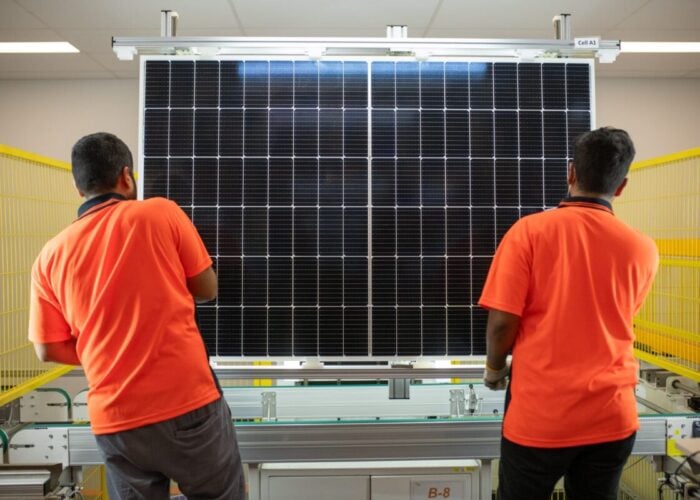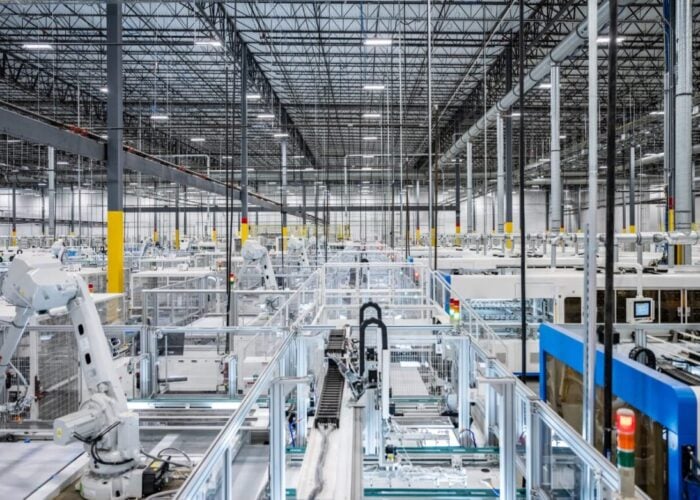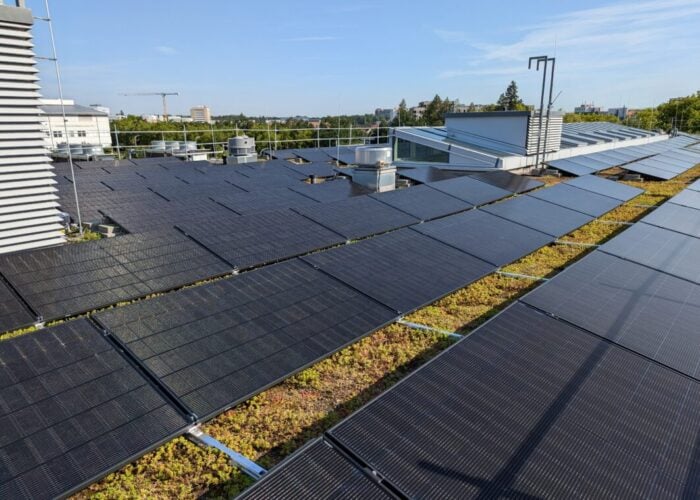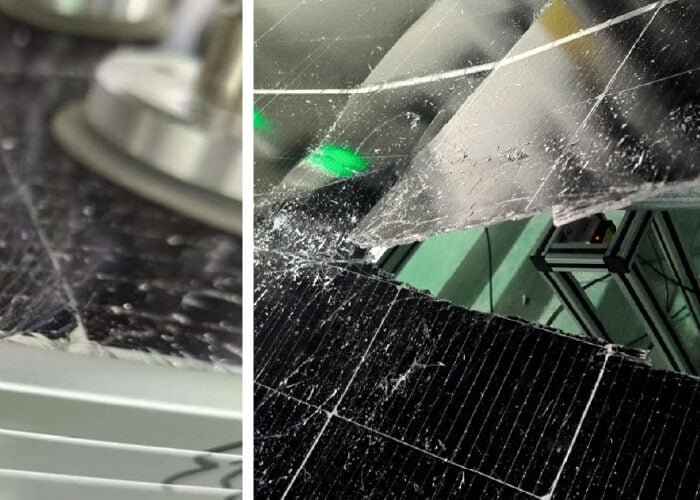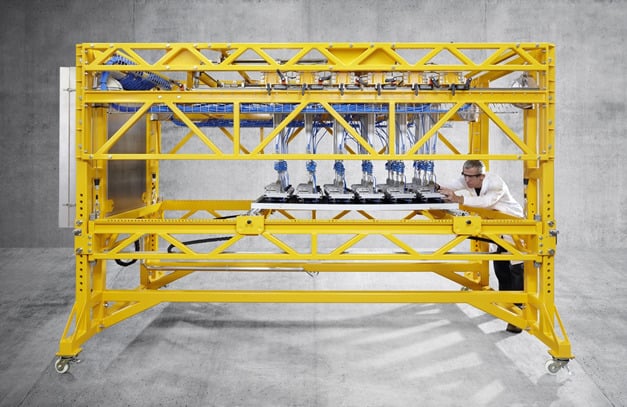
Over the past five years, solar panel design has evolved, with larger modules, thinner frames and different glass types becoming more commonplace. However, a representative from an independent third-party PV test and research lab suggests that this had led to a weakening of mechanical stability in modules.
“We’ve seen a dramatic rise in the number of projects in the field, that we have been asked to work on, where they have had mechanical failures, meaning module glass breaking, at unexpected, or concerning stages in the project’s life; sometimes as early as before the plant has even been commissioned,” Colin Sillerud, vice president of engineering at Albuquerque-based test lab CFV Labs, tells PV Tech Premium.
Unlock unlimited access for 12 whole months of distinctive global analysis
Photovoltaics International is now included.
- Regular insight and analysis of the industry’s biggest developments
- In-depth interviews with the industry’s leading figures
- Unlimited digital access to the PV Tech Power journal catalogue
- Unlimited digital access to the Photovoltaics International journal catalogue
- Access to more than 1,000 technical papers
- Discounts on Solar Media’s portfolio of events, in-person and virtual
Sillerud notes that potential solutions currently exist in the industry, from updating the testing process to using different materials such as steel, suggesting that as module design adapts and evolves, module resilience has the potential to improve in tandem.
Changing module design
The first key technological advancements in recent years resulting in a decline in PV module strength is the trend of modules getting larger. Traditionally standard module design stood at 1x2m, but over recent years solar cells have increased in size, pushing up module size in tandem.
Secondly, module frames, which have historically been 40mm thick, have become thinner, to an average of 35mm. This has a substantial weakening effect on the mechanical stability of the module, given that – using beam theory in structural mechanics – the height of the frame dictates the majority of its strength.
These frame height changes also push the structural burden from the frame onto the module glass, and that poses some challenges because the glass has a different break pattern and behaviour than the metal does.
Thirdly, the use of glass has changed. Modules used to use 3.2mm tempered glass with a back sheet, but now tend to use two sheets of 2mm heat-strengthened glass. When using two sheets, both still behave as independent sheets in terms of their strength without adding to each other’s strength.
These changes have been driven by different motives. Although the increase in module sizes does play on the marketing feature of chasing nameplate power, this is more a general function of the cell size increase, according to Sillerud.
Thinning frames, on the other hand, has been primarily a cost-cutting measure driven by lowering spend on material for the frame, while also being able to pack more modules into a shipping container to reduce shipping costs.
Using thinner glass also saves money, while switching to bifacial models of glass-glass instead of glass-back sheet tends to reduce incursion of moisture and increases durability in extreme sunlight, for example. In general, the glass-glass package is “more environmentally robust,” adds Sillerud, which is important as manufacturers look to minimise the environmental impacts of their products.
Poor testing performance
The team at CFV Labs started noticing the decline in module strength around 2018-19, around the time the industry started moving from the 3.2mm tempered glass with the back sheet, to the 2mm heat-strengthened glass-glass package. The lab also saw the cost-cutting measures of frame height reductions with some frame thicknesses going from 40mm to as thin as 25mm in some cases.
To be approved, most large-scale PV sites in the US require a compliance test using a site-specific load. An independent engineer or firm comes on site and calculates the worst-case loading scenario to be expected based on historical weather data and then a single module is tested with the clamps and torque tubes that are going to be used in that particular installation. The tests are done at 1.5x the site-specific load, which is an IEC specification for converting a design load into a test load.
CFV carries out around 30 such tests each year at different locations. Between 2014-18, modules “basically never failed” the qualification tests, with Sillerud recounting just one failure in those four years. However, from 2019 the lab saw an average of around 30% of the modules failing when tested based on the expected design load for the site, which has led to CFV looking more deeply into the issue and doing its own research.
“We see a decoupling between what modules are expected to survive based on previous industry knowledge, and what they’re actually able to survive in testing,” explains Sillerud, suggesting that the testing process may no longer be effective.
Lauren Ahsler, vice president of engineering at steel solar panel frame developer Origami Solar agrees, saying that certification testing loads have been reduced in response to module changes, resulting in a lower factor of safety built into many PV projects.
“This is showing up in the form of field failures and breakage during installation, thus becoming a topic of urgent concern for engineering, procurement and construction firms (EPCs) and developers,” says Ahsler.
Confirming CFV Labs’ findings are in alignment with observations and concerns brought by a wide range of technical experts in the PV industry, Ahsler adds: “There has been a consistent drive towards higher wattage modules while also driving down module and overall system costs. This has resulted in a push towards less material and therefore less strength in both the glass and the aluminium frame of PV modules.”
Breakage in the field
When project operators deal with damaged solar panels, the first action is to ask whether there has been an extreme weather event. For example, PV Tech recently reported “golf ball-sized hail” damaging the 350MW Fighting Jays solar project in south-east Texas, which could raise questions about the strength of the modules deployed at the project.
However, Sillerud says none of the projects CFV Labs has tested, with installations between six months to five years, have experienced weather that could be classified as what he calls “extreme” or “an act of God”. All the cases have had strong weather to varying degrees, but none have had weather that was outside what would be expected for normal operating conditions.
When modules are damaged, the breakages usually take one of two forms. The first involves the modules catastrophically failing, “where they’re literally bent over the tube and the glass is shattered, or parts of the module are missing and falling to the ground,” says Sillerud, noting that this occurs during strong, but not unexpected, weather events.
In the second type of failure, the module remains intact but has one or two cracks through the glass running along either or both of the front and back sides. Such damage can be expected from internal module stresses coupled with high frequency and low amplitude stress, which relates more to normal operating conditions, for example, with winds of just 20 miles per hour.
”Building plants to make the system more robust”
While mechanical strength has decreased over the five years and there is increased module breakage in the field, Sillerud says it’s important to remember that PV modules are part of a mechanical system and the issue can be addressed relatively quickly using technologically that already exists but needs scaling up.
“There are things that can actually be done by developers, when they’re building plants to make the system more robust,” adds Sillerud.
Thus, CFV Labs’ first recommendation is to use larger mountings systems such as larger rails or upgrading from 400mm centre clamps to 600mm centre clamps, or to 1,400mm steel rails.
Sillerud also emphasises that at present only a single module is being tested to qualify an entire plant, so CFV Labs’ second main recommendation is to test multiple modules from any one project.
“It looks like we are pushing modules to the point where their mechanical stability, and what they’re expected to do, are so close together, that when you do a single test, you’re in the realm where one module might pass and if you test another module, it might fail,” he says. “So, testing multiple modules for projects, we think has become much more important.”
CFV Labs has also developed a test-to-failure method to understand what the strength limit of a module is and how close the test pressures for the static load test are to that failure limit. For its third recommendation, the lab recommends using this test-to-failure approach to address customer concerns about module strength and design loads.
Steel frame alternatives
In related news, after testing at CFV Labs and the Renewable Energy Test Center (RETC), modules using Origami’s steel frames have passed frame-related industry-standard tests required to support module maker certifications including those of the International Electrotechnical Commission (IEC).
Steel is an inherently stronger and more fatigue-resistant material than aluminium, she adds. The properties of steel coupled with the capabilities of modern roll-forming processes allow for a wide range of optimisation possibilities when compared to aluminium extrusion. These properties enable steel frames to maintain the strength and durability expected in solar with a cost-competitive frame.
Steel also has a superior fatigue strength versus aluminium, which is relevant to the design of flexible structures, such as solar racking, which will see high cycles of dynamic loading wind stresses over a project lifetime, making it a useful alternative.
“The industry clearly has a problem and stronger steel frames can play in role in addressing it,” says Ahsler.



